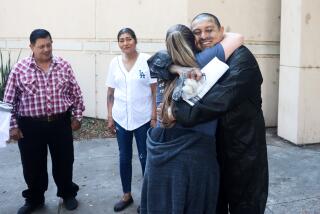D.A. Must Weigh Fate of Boy Who Killed on Joy Ride
A lot of childrenâs and adolescentsâ cases go through the district attorneyâs office at Orange County Juvenile Court, said Deputy Dist. Atty. Cheryl Bedsworth. âTen thousand a year. Itâs amazing.â
Fullerton police expect to bring in another next week, the case of an 11-year-old Garden Grove boy who took his parentsâ 24-foot motor home for a joy ride Tuesday and wound up killing a 72-year-old woman.
âWe get 11-year-olds joy riding all the time,â Bedsworth said. âUsually they crash into a tree or a wall, and thatâs how they get caught.â
But Fullertonâs joy rider crashed broadside into a car carrying Margaret D. Rooney of Fullerton, who died four hours later. Now a legal system that more frequently handles 11-year-olds as shoplifters, thieves or burglars will be asked to handle one who killed.
Should he be treated as a killer? No one seems eager to decide that question.
âFortunately for us, I guess, we donât have to make the final decision,â said Fullerton Police Sgt. Al Burks, whose traffic bureau is investigating the fatal crash.
âOnce we wrap up our investigation, weâll present it to the district attorneyâs office for review. If they determine a prosecution is warranted, then weâre there to answer whatever questions they might have.
âFrankly, we donât know what theyâll do. Weâve never had one this young.â
John D. Conley, supervisor of the D.A.âs Juvenile Court prosecutors, is no stranger to young criminals. âTo have a young kid involved in a crime is not unusual,â he said. âTo have a loss of human life involved is very unusual.â
The question of how to handle the case may not require a discretionary decision.
Under state law, a child less than 14 years old cannot be convicted of a crime unless it is proved that the child knew he was doing something wrong.
Exercise Discretion?
But if the proof is there, Conley said, it opens the door to a more difficult question: âShould we exercise the discretion we have as prosecutors not to (prosecute)?â
County Probation Department statistics show that children 11 or younger make up a very small percentage of those accused in juvenile criminal cases in Orange County.
In 1985, for example, 17,951 children and adolescents were arrested in Orange County, but only 275, about 1.5%, were 11 years old or younger.
Only 84 of them, about 0.5%, were arrested for felonies, mostly burglaries. Two robberies and one weapons violation were listed. There were no crimes involving death.
âUnless itâs a serious crime like this, elementary school administrators try to handle things on that level,â said Fullerton Police Sgt. Wage Richmond, who specializes in juvenile cases.
âPolice involvement at that stage is seldom necessary. . . . Weâve had them this young periodically--in here for fighting and disrupting school and being incorrigible. But nothing this heavy, no.â
Burks said that if an adult had been at the wheel of the motor home, âthere wouldnât be as much doubt about prosecution.â
Mitigating Circumstances
But with an 11-year-old suspect, investigators encounter possible mitigating circumstances at every turn.
âThe impression I get was the young man was somewhat frustrated, probably with problems at school, and wanted to get out and get away from things,â Burks said. âHeâs not a juvenile delinquent type. Heâs been very cooperative. Itâs not like heâs a problem child.
âHe seemed like an average-looking kid, not one youâd describe as the radical type, long hair, whatever. He was well dressed. It would be hard to pick him out of a group of his peers.â
Burks said that a relative of the victim called the police station and during the conversation remarked that âthey felt sorry for the young man and all heâll have to go through.â
Burks said there are no firm guidelines for police dealing with children that young. âIf theyâre under 14, we have to evaluate them on a case-by-case basis,â he said.
So does the D.A., Conley said. One 10-year-old boy who sodomized two five-year-olds was prosecuted, convicted and confined, he said.
But a 12-year-old arrested for burglary was treated instead as a petty thief, Bedsworth said. He admitted going through the unlocked back door of a neighborâs house to steal something and wound up stealing a bag of corn chips lying on a counter.
Tough Prosecutors
Bedsworth said she used the facts of the case as an exercise during last monthâs California District Attorneyâs Assn. juvenile justice seminar in Palm Springs. She asked prosecutors from around California how they would treat the case.
âI found a lot of the ones from the northern counties were a lot more--I donât want to use the word redneck--but hard-charging. They wanted to file for burglary, which is a felony.
âThey wanted to consider mitigating aspects at the sentencing stage. We tend to consider them more at the time of filing (a charge). It might be a function of the fact that we have a lot more cases than a lot of them do.
âBut for crying out loud, the kidâs 12 years old and itâs a bag of Fritos. Itâs not like heâs selling VCRs to support his drug habit.â
Did the 11-year-old know he was doing something wrong when he took his parentsâ motor home, cruised for âmost of the afternoon,â then, with a police car flashing its lights and honking at him, lost control and rammed the Rooney car?
âThatâs the twist,â Conley said. âIn this kind of case, the awareness of the child is sometimes the decisive factor.â
More to Read
Sign up for Essential California
The most important California stories and recommendations in your inbox every morning.
You may occasionally receive promotional content from the Los Angeles Times.










